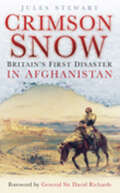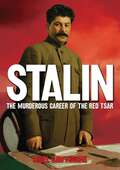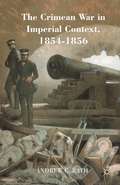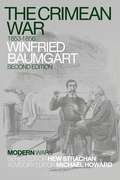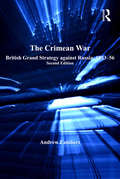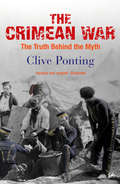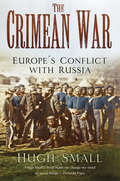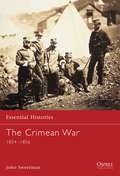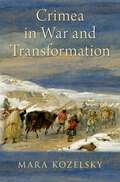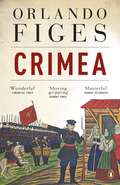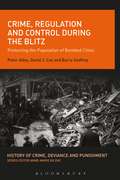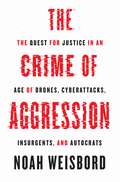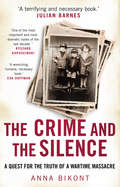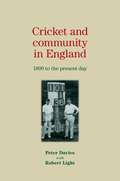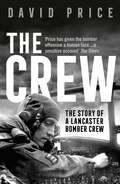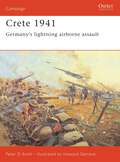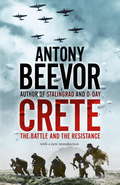- Table View
- List View
Crimson Snow: Britain's First Disaster in Afghanistan (Sutton Ser.)
by Jules StewartIn the mid-nineteenth century, the British and Russian Empires played the ‘Great Game,’ a rivalry for supremacy in Central Asia. To secure a ‘buffer zone’ in Afghanistan, between India and Russian territory, Britain launched the First Anglo-Afghan War in 1838. Initial success, including the imposition of a puppet regime supported by too few troops (a situation that has great resonance today), was followed by complete disaster in 1842, with 4,500 soldiers and 12,000 civilian camp followers killed by rebellious Afghans. Only one Briton is known to have escaped the massacre. This compelling story of imperial misadventure is told by Jules Stewart, a former Reuters journalist with considerable experience in the region and a specialist in North-West Frontier history, and has a foreword from General Sir David Richards, Chief of the General Staff and a former NATO commander in Afghanistan. It provides important parallels with our current commitments in this graveyard of ambitions, and illustrates how little has been learnt from the past.
The Crimson Portrait: A Novel
by Jody ShieldsSet in England during World War I, this haunting love story by the author of the bestselling The Fig Eater makes unforgettably real the ravages of love and war.
The Crimes of Stalin: The Murderous Career of the Red Tsar
by Nigel Cawthorne'Death is the solution to all problems. No man - no problem.'-Joseph StalinWorshipped by the Russians as a great leader, Stalin was one of modern history's greatest tyrants, rivalling Hitler, Mao Zedong and Pol Pot. But he probably had more blood on his hands than any of them.Born Josef Dzhugashvili in Gori, Georgia in 1879, Stalin studied to be a priest while secretly reading the works of Karl Marx. Politics soon became his religion and, under his ruthless rule, up to 60 million people perished.Peasants who resisted Stalin's policy of collectivisation were denounced as Kulaks, arrested and shot, exiled or worked to death in his ever-expanding network of concentration camps, the Gulag. Nobody was safe, not even his friends, his family or his political allies. This is the story of a man who never let up for a second in his pursuit of absolute power.
The Crimean War in Imperial Context, 1854-1856
by Andrew RathThe Crimean War was fought far from its namesake peninsula in Ukraine. Until now, accounts of Britain's and France's naval campaigns against Czarist Russia in the Baltic, White Sea, and Pacific have remained fragmented, minimized, or thinly-referenced. This book considers each campaign from an imperial perspective extending from South America to Finland. Ultimately, this regionally-focused approach reveals that even the smallest Anglo-French naval campaigns in the remote White Sea had significant consequences in fields ranging from medical advances to international maritime law. Considering the perspectives of neutral powers including China, Japan, and Sweden-Norway, allows Rath to examine the Crimean conflict's impact on major historical events ranging from the 'opening' of Tokugawa Japan to Russia's annexation of large swaths of Chinese territory. Complete with customized maps and an extensive reference section, this will become essential reading for a varied audience.
The Crimean War: 1853-1856 (Modern Wars)
by Winfried BaumgartWinfried Baumgart's masterful history of the Crimean War has been expanded and fully updated to reflect advances made in the field since the book's first publication. It convincingly argues that if the war had continued after 1856, the First World War would have taken place 60 years earlier, but that fighting ultimately ceased because diplomacy never lost its control over the use of war as an instrument in power politics.With 19 images, 13 maps and additional tables as well as a brand new chapters on 'the medical services', this expanded and fully-updated 2nd edition explores* The origins and diplomacy of the Crimean War* The war aims and general attitudes of the belligerent powers (Russia, France, and Britain), non-belligerent German powers (Austria and Prussia) and a selected number of neutral powers, including the United States* The characteristics and capabilities of the armies involved* The nature of the fighting itselfThe Crimean War: 1853-1856 examines the conflict in both its Europe-wide and global contexts, moving beyond the five great European powers to consider the role and importance of smaller states and theatres of war that have otherwise been under-served. To this end, it looks at fighting on the Danube front, the Black Sea, the Baltic Sea, the Caucasian battlefield, as well as the White Sea and the Pacific, with final chapters devoted to the Paris peace congress of 1856, the end of the war and its legacy.This book remains the definitive study of one of the most important wars in modern history.
The Crimean War: 1853-1856 (Modern Wars)
by Winfried BaumgartWinfried Baumgart's masterful history of the Crimean War has been expanded and fully updated to reflect advances made in the field since the book's first publication. It convincingly argues that if the war had continued after 1856, the First World War would have taken place 60 years earlier, but that fighting ultimately ceased because diplomacy never lost its control over the use of war as an instrument in power politics.The book explores:* The origins and diplomacy of the Crimean War* The war aims and general attitudes of the belligerent powers (Russia, France, and Britain), non-belligerent German powers (Austria and Prussia) and a selected number of neutral powers, including the United States* The characteristics and capabilities of the armies involved* The nature of the fighting itselfThe Crimean War: 1853-1856 examines the conflict in both its Europe-wide and global contexts, moving beyond the five great European powers to consider the role and importance of smaller states and theatres of war that have otherwise been under-served. To this end, it looks at fighting on the Danube front, the Black Sea, the Baltic Sea, the Caucasian battlefield, as well as the White Sea and the Pacific, with final chapters devoted to the Paris peace congress of 1856, the end of the war and its legacy.With 19 images, 13 maps and additional tables, as well as a brand new chapter on 'the medical services', this book remains the definitive study of one of the most important wars in modern history.
The Crimean War: British Grand Strategy against Russia, 1853–56
by Andrew LambertIn contrast to every other book about the conflict Andrew Lambert's ground-breaking study The Crimean War: British Grand Strategy against Russia, 1853-1856 is neither an operational history of the armies in the Crimea, nor a study of the diplomacy of the conflict. The core concern is with grand strategy, the development and implementation of national policy and strategy. The key concepts are strategic, derived from the works of Carl von Clausewitz and Sir Julian Corbett, and the main focus is on naval, not military operations. This original approach rejected the 'Continentalist' orthodoxy that dominated contemporary writing about the history of war, reflecting an era when British security policy was dominated by Inner German Frontier, the British Army of the Rhine and Air Force Germany. Originally published in 1990 the book appeared just as the Cold War ended; the strategic landscape for Britain began shifting away from the continent, and new commitments were emerging that heralded a return to maritime strategy, as adumbrated in the defence policy papers of the 1990s. With a new introduction that contextualises the 1990 text and situates it in the developing historiography of the Crimean War the new edition makes this essential book available to a new generation of scholars.
The Crimean War: British Grand Strategy against Russia, 1853–56
by Andrew LambertIn contrast to every other book about the conflict Andrew Lambert's ground-breaking study The Crimean War: British Grand Strategy against Russia, 1853-1856 is neither an operational history of the armies in the Crimea, nor a study of the diplomacy of the conflict. The core concern is with grand strategy, the development and implementation of national policy and strategy. The key concepts are strategic, derived from the works of Carl von Clausewitz and Sir Julian Corbett, and the main focus is on naval, not military operations. This original approach rejected the 'Continentalist' orthodoxy that dominated contemporary writing about the history of war, reflecting an era when British security policy was dominated by Inner German Frontier, the British Army of the Rhine and Air Force Germany. Originally published in 1990 the book appeared just as the Cold War ended; the strategic landscape for Britain began shifting away from the continent, and new commitments were emerging that heralded a return to maritime strategy, as adumbrated in the defence policy papers of the 1990s. With a new introduction that contextualises the 1990 text and situates it in the developing historiography of the Crimean War the new edition makes this essential book available to a new generation of scholars.
The Crimean War: The Truth Behind the Myth
by Clive PontingThe Crimean War is full of resonance - not least, the Charge of the Light Brigade, the Siege of Sevastopol and Florence Nightingale at Scutari with her lamp. In this fascinating book, Clive Ponting separates the myths from the reality, and tells the true story of the heroism of the ordinary soldiers, often through eye-witness accounts of the men who fought and those who survived the terrible winter of 1854-55. To contemporaries, it was 'The Great War with Russia' - fought not only in the Black Sea and the Crimea but in the Baltic, the Arctic, the Pacific and the Caucasus. Ironically, Britain's allies were France, her traditional enemy, ably commanded (from home) by Napoleon III himself, and the Muslim Ottoman Empire, widely seen as an infidel corrupt power. It was the first of the 'modern' wars, using rifles, artillery, trench systems, steam battleships, telegraph and railways; yet the British soldiers wore their old highly coloured uniforms and took part in their last cavalry charge in Europe. There were over 650,000 casualties. Britain was unable fully to deploy her greatest strength, her Navy, while her Army was led by incompetent aristocrats. The views of ordinary soldiers about Raglan, Cardigan and Lucan make painful reading.
The Crimean War: Europe's Conflict with Russia
by Hugh SmallIn the winter of 1854, Britain and France, with Europe-wide support, invaded Russia and besieged the fortress of Sebastopol in the Crimea. Their object was to curtail Russian expansion. It was the most destructive conflict of the century, with total fatalities comparable to those of the American Civil War. Hugh Small, whose biography of Florence Nightingale first exposed the truth about her wartime hospital, now shows how the history of the Crimean War was manipulated to conceal Britain and Europe’s failure. Only since the collapse of the Soviet Union has it become clear how much had been at stake in the Crimea. The failure of Britain’s politicians to control their generals led to the collapse of the peacekeeping arrangements of the ‘Concert of Europe’ – a sort of early UN Security Council. Russian expansion continued unchecked, leading to the divisions seen today in Ukraine. Small is equally revealing about the battles. His carefully-researched account of the famous Charge of the Light Brigade overturns the modern conclusion that it was a blunder by senior officers. It was the ordinary cavalrymen who insisted on it – as the Commander-in-Chief admitted in parliament at the time.
The Crimean War: 1854–1856 (Guide to...)
by John SweetmanThis bitter war between Russia and Turkey, aided by Britain and France, was the setting for the stuff of legends. This book details the gallant yet suicidal Charge of the Light Brigade, now immortalised in film: in the words of Tennyson, 'Into the Valley of Death rode the Six Hundred'. It relates the reports made by the first real war correspondant, William Russell of the London Times - reports which served only to highlight the army's problems - and memorialises the heroic deeds of Florence Nightingale, who struggled to save young men from the most formidable enemy in the Crimean War: not the Russians, but cholera.
Crimea in War and Transformation
by Mara KozelskyCrimea in War and Transformation is the first book to examine the terrible toll of violence on Crimean civilians and landscapes from mobilization through reconstruction. When war landed on Crimea's coast in September 1854, multiple armies instantly doubled the peninsula's population. Engineering brigades mowed down forests to build barracks. Ravenous men fell upon orchards like locusts and slaughtered Crimean livestock. Within a month, war had plunged the peninsula into a subsistence crisis. Soldiers and civilians starved as they waited for food to travel from the mainland by oxcart at a rate of ½ mile per hour. Every army conscripted Tatars as laborers, and fired upon civilian homes. Several cities and villages-Sevastopol, Kerch, Balaklava, Genichesk among them-burned to the ground. At the height of violence, hysterical officers accused Tatars of betrayal and deported large segments of the local population. Peace did not bring relief to Crimea's homeless and hungry. Removal of dead bodies and human waste took months. Epidemics swept away young children and the elderly. Russian officials estimated the devastation wrought by Crimean War exceeded that of Napoleon's invasion. Recovery packages failed human need, and by 1859, the trickle of Tatar out-migration that had begun during the war turned into a flood. Nearly 200,000 Tatars left Crimea by 1864, adding a demographic crisis to the tally of war's destruction. Drawing from a wide body of published and unpublished material, including untapped archives, testimonies, and secret police files from Russia, Ukraine and Crimea, Mara Kozelsky details in readable and vivid prose the toll of war on the Crimean people, and the Russian Empire as a whole, from mobilization through failed efforts at reconstruction.
Crimea in War and Transformation
by Mara KozelskyCrimea in War and Transformation is the first book to examine the terrible toll of violence on Crimean civilians and landscapes from mobilization through reconstruction. When war landed on Crimea's coast in September 1854, multiple armies instantly doubled the peninsula's population. Engineering brigades mowed down forests to build barracks. Ravenous men fell upon orchards like locusts and slaughtered Crimean livestock. Within a month, war had plunged the peninsula into a subsistence crisis. Soldiers and civilians starved as they waited for food to travel from the mainland by oxcart at a rate of ½ mile per hour. Every army conscripted Tatars as laborers, and fired upon civilian homes. Several cities and villages-Sevastopol, Kerch, Balaklava, Genichesk among them-burned to the ground. At the height of violence, hysterical officers accused Tatars of betrayal and deported large segments of the local population. Peace did not bring relief to Crimea's homeless and hungry. Removal of dead bodies and human waste took months. Epidemics swept away young children and the elderly. Russian officials estimated the devastation wrought by Crimean War exceeded that of Napoleon's invasion. Recovery packages failed human need, and by 1859, the trickle of Tatar out-migration that had begun during the war turned into a flood. Nearly 200,000 Tatars left Crimea by 1864, adding a demographic crisis to the tally of war's destruction. Drawing from a wide body of published and unpublished material, including untapped archives, testimonies, and secret police files from Russia, Ukraine and Crimea, Mara Kozelsky details in readable and vivid prose the toll of war on the Crimean people, and the Russian Empire as a whole, from mobilization through failed efforts at reconstruction.
Crimea: The Last Crusade
by Orlando FigesThe terrible conflict that dominated the mid 19th century, the Crimean War killed at least 800,000 men and pitted Russia against a formidable coalition of Britain, France and the Ottoman Empire. It was a war for territory, provoked by fear that if the Ottoman Empire were to collapse then Russia could control a huge swathe of land from the Balkans to the Persian Gulf. But it was also a war of religion, driven by a fervent, populist and ever more ferocious belief by the Tsar and his ministers that it was Russia's task to rule all Orthodox Christians and control the Holy Land.Orlando Figes' major new book reimagines this extraordinary war, in which the stakes could not have been higher and which was fought with a terrible mixture of ferocity and incompetence. It was both a recognisably modern conflict - the first to be extensively photographed, the first to employ the telegraph, the first 'newspaper war' - and a traditional one, with illiterate soldiers, amateur officers and huge casualties caused by disease. Drawing on a huge range of fascinating sources, Figes also gives the lived experience of the war, from that of the ordinary British soldier in his snow-filled trench, to the haunted, gloomy, narrow figure of Tsar Nicholas himself as he vows to take on the whole world in his hunt for religious salvation.
Crime, Regulation and Control During the Blitz: Protecting the Population of Bombed Cities (History of Crime, Deviance and Punishment)
by Peter Adey David J. Cox Barry GodfreyCrime, Regulation and Control during the Blitz looks at the social effect of bombing on urban centres like Liverpool, Coventry and London, critically examining how the wartime authorities struggled to regulate and control crime and offending during the Blitz. Focusing predominantly on Liverpool, it investigates how the authorities and citizens anticipated the aerial war, and how the State and local authorities proposed to contain and protect a population made unruly, potentially deviant and drawn into a new landscape of criminal regulation.Drawing on a range of contemporary sources, the book throws into relief today's experiences of war and terror, the response in crime and deviancy, and the experience and practices of preparedness in anticipation of terrible threats. The authors reveal how everyday activities became criminalised through wartime regulations and explore how other forms of crime such as looting, theft and drunkenness took on a new and frightening aspect. Crime, Regulation and Control during the Blitz offers a critical contribution to how we understand crime, security, and regulation in both the past and the present.
Crime, Regulation and Control During the Blitz: Protecting the Population of Bombed Cities (History of Crime, Deviance and Punishment)
by Peter Adey David J. Cox Barry GodfreyCrime, Regulation and Control during the Blitz looks at the social effect of bombing on urban centres like Liverpool, Coventry and London, critically examining how the wartime authorities struggled to regulate and control crime and offending during the Blitz. Focusing predominantly on Liverpool, it investigates how the authorities and citizens anticipated the aerial war, and how the State and local authorities proposed to contain and protect a population made unruly, potentially deviant and drawn into a new landscape of criminal regulation.Drawing on a range of contemporary sources, the book throws into relief today's experiences of war and terror, the response in crime and deviancy, and the experience and practices of preparedness in anticipation of terrible threats. The authors reveal how everyday activities became criminalised through wartime regulations and explore how other forms of crime such as looting, theft and drunkenness took on a new and frightening aspect. Crime, Regulation and Control during the Blitz offers a critical contribution to how we understand crime, security, and regulation in both the past and the present.
The Crime of Aggression: The Quest for Justice in an Age of Drones, Cyberattacks, Insurgents, and Autocrats (Human Rights and Crimes against Humanity #36)
by Noah WeisbordA gripping behind-the-scenes account of the dramatic legal fight to hold leaders personally responsible for aggressive warOn July 17, 2018, starting an unjust war became a prosecutable international crime alongside genocide, crimes against humanity, and war crimes. Instead of collective state responsibility, our leaders are now personally subject to indictment for crimes of aggression, from invasions and preemptions to drone strikes and cyberattacks. The Crime of Aggression is Noah Weisbord’s riveting insider’s account of the high-stakes legal fight to enact this historic legislation and hold politicians accountable for the wars they start.Weisbord, a key drafter of the law for the International Criminal Court, takes readers behind the scenes of one of the most consequential legal dramas in modern international diplomacy. Drawing on in-depth interviews and his own invaluable insights, he sheds critical light on the motivations of the prosecutors, diplomats, and military strategists who championed the fledgling prohibition on unjust war—and those who tried to sink it. He untangles the complex history behind the measure, tracing how the crime of aggression was born at the Nuremberg trials only to fall dormant during the Cold War, and he draws lessons from such pivotal events as the collapse of the League of Nations, the rise of the United Nations, September 11, and the war on terror.The power to try leaders for unjust war holds untold promise for the international order, but also great risk. In this incisive and vitally important book, Weisbord explains how judges in such cases can balance the imperatives of justice and peace, and how the fair prosecution of aggression can humanize modern statecraft.
The Crime of Aggression: The Quest for Justice in an Age of Drones, Cyberattacks, Insurgents, and Autocrats (Human Rights and Crimes against Humanity #36)
by Noah WeisbordA gripping behind-the-scenes account of the dramatic legal fight to hold leaders personally responsible for aggressive warOn July 17, 2018, starting an unjust war became a prosecutable international crime alongside genocide, crimes against humanity, and war crimes. Instead of collective state responsibility, our leaders are now personally subject to indictment for crimes of aggression, from invasions and preemptions to drone strikes and cyberattacks. The Crime of Aggression is Noah Weisbord’s riveting insider’s account of the high-stakes legal fight to enact this historic legislation and hold politicians accountable for the wars they start.Weisbord, a key drafter of the law for the International Criminal Court, takes readers behind the scenes of one of the most consequential legal dramas in modern international diplomacy. Drawing on in-depth interviews and his own invaluable insights, he sheds critical light on the motivations of the prosecutors, diplomats, and military strategists who championed the fledgling prohibition on unjust war—and those who tried to sink it. He untangles the complex history behind the measure, tracing how the crime of aggression was born at the Nuremberg trials only to fall dormant during the Cold War, and he draws lessons from such pivotal events as the collapse of the League of Nations, the rise of the United Nations, September 11, and the war on terror.The power to try leaders for unjust war holds untold promise for the international order, but also great risk. In this incisive and vitally important book, Weisbord explains how judges in such cases can balance the imperatives of justice and peace, and how the fair prosecution of aggression can humanize modern statecraft.
The Crime and the Silence: Confronting Memory In Jedwabne
by Anna BikontWinner of the European Book Prize'A masterpiece' Jan T. Gross'Terrifying and necessary' Julian Barnes'Scrupulously objective and profoundly personal' Kate AtkinsonOn 10 July 1941 a horrifying crime was committed in the small Polish town of Jedwadbne. Early in the afternoon, the town’s Jewish population – hundreds of men, women and children – were ordered out of their homes, and marched into the town square. By the end of the day most would be dead. It was a massacre on a shocking scale, and one that was widely condemned. But only a few people were brought to justice for their part in the atrocity. The truth of what actually happened on that day was to be suppressed for more than sixty years. Part history, part memoir, part investigation, The Crime and the Silence is an award-winning journalist's account of the events of that day: both the story of a massacre told through oral histories of survivors and witnesses, and a portrait of a Polish town coming to terms with its dark past.
Cricket and community in England: 1800 to the present day (PDF)
by Peter DaviesAvailable in paperback for the first time, Cricket and Community in England: 1800 to the Present Day is a path-breaking enquiry into the social history of the summer game. It is written by two specialist cricket historians and based on extensive primary research. It traces the history of the sport at grassroots level from its origins right up to the present day. It will appeal to the cricket historian and the general sports enthusiast alike. The book has two main goals: to provide readers with an accessible introduction to the history of grassroots cricket in England and to supply a clear overview of the different phases of this history. The structure of book is chronological but also thematic. The six chapters look at such issues as early cricket, the origins of clubs, competition, the two world wars, multiculturalism and cricket in the twenty-first century.
Cricket and community in England: 1800 to the present day (G - Reference,information And Interdisciplinary Subjects Ser.)
by Peter DaviesAvailable in paperback for the first time, Cricket and Community in England: 1800 to the Present Day is a path-breaking enquiry into the social history of the summer game. It is written by two specialist cricket historians and based on extensive primary research. It traces the history of the sport at grassroots level from its origins right up to the present day. It will appeal to the cricket historian and the general sports enthusiast alike. The book has two main goals: to provide readers with an accessible introduction to the history of grassroots cricket in England and to supply a clear overview of the different phases of this history. The structure of book is chronological but also thematic. The six chapters look at such issues as early cricket, the origins of clubs, competition, the two world wars, multiculturalism and cricket in the twenty-first century.
The Crew: The Story of a Lancaster Bomber Crew
by David PriceA moving tribute to the sacrifice and bravery of the fliers of RAF Bomber Command. ****************************** The Crew, based on interviews with Ken Cook, the crew's sole surviving member, recounts the wartime exploits of the members of an Avro Lancaster crew between 1942 and the war's end. Gloucestershire-born bomb aimer Ken Cook, hard-bitten Australian pilot Jim Comans, Navigator Don Bowes, Upper Gunner George Widdis, Tail Gunner 'Jock' Bolland, Flight Engineer Ken Randle and Radio Operator Roy Woollford were seven ordinary young men living in extraordinary times, risking their lives in freedom's cause in the dark skies above Hitler's Reich. From their earliest beginnings – in places as far apart as a Cotswold village and the suburbs of Sydney – through the adventure of training in North America and the dread and danger of the forty-five bombing raids they flew with 97 Squadron, David Price describes the crew's wartime experiences with human sympathy allied to a secure technical understanding of one of the RAF's most iconic aircraft. The drama and anxiety of individual missions – to Kassel, Munich and Augsburg as well as Berlin – is evoked with thrilling immediacy; while the military events and strategic decisions that drove the RAF's area bombing campaign against Nazi Germany are interwoven deftly with the narrative of the crew's operational careers. ****************************** Reviews: 'A sensitive account of the bomber's life... Price has given the bomber offensive a human face. This book [...] has a heart and soul' The Times. 'A fascinating and fast-paced account of the exploits of an Avro Lancaster bomber crew from 97 Squadron RAF' The Herald. 'A remarkable insight into the bravery, determination and skill of British Bomber Command crews during WWII' Waterstones.
Crete 1941: Germany’s lightning airborne assault (Campaign)
by Howard Gerrard Peter AntillOperation Mercury, the German airborne assault on the island of Crete in May 1941, was the first strategic use of airborne forces in history. The assault began on 20 May, with landings near the island's key airports, and reinforcements the next day allowed the German forces to capture one end of the runway at Maleme. By 24 May, the Germans were being reinforced by air on a huge scale and on 1 June Crete surrendered. This book describes how desperately close the battle had been and explains how German losses so shocked the Führer that he never again authorised a major airborne operation.
Crete 1941: Germany’s lightning airborne assault (Campaign #147)
by Howard Gerrard Peter AntillOperation Mercury, the German airborne assault on the island of Crete in May 1941, was the first strategic use of airborne forces in history. The assault began on 20 May, with landings near the island's key airports, and reinforcements the next day allowed the German forces to capture one end of the runway at Maleme. By 24 May, the Germans were being reinforced by air on a huge scale and on 1 June Crete surrendered. This book describes how desperately close the battle had been and explains how German losses so shocked the Führer that he never again authorised a major airborne operation.
Crete: The Battle and the Resistance (History And Warfare Ser.)
by Antony BeevorAcclaimed historian and best-selling author Antony Beevor vividly brings to life the epic struggles that took place in Second World War Crete - reissued with a new introduction.'The best book we have got on Crete' ObserverThe Germans expected their airborne attack on Crete in 1941 - a unique event in the history of warfare - to be a textbook victory based on tactical surprise. They had no idea that the British, using Ultra intercepts, knew their plans and had laid a carefully-planned trap. It should have been the first German defeat of the war, but a fatal misunderstanding turned the battle round. Nor did the conflict end there. Ferocious Cretan freedom fighters mounted a heroic resistance, aided by a dramatic cast of British officers from Special Operations Executive.
